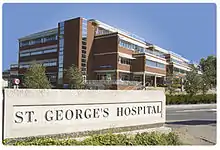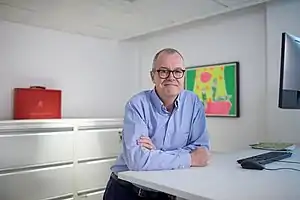Patrick Vallance
Sir Patrick John Thompson Vallance FRS FMedSci FRCP (born 17 March 1960)[1] is a British physician, scientist, and clinical pharmacologist who has worked in both academia and industry. He has served as the Chief Scientific Adviser to the Government of the United Kingdom since March 2018.
Sir Patrick Vallance | |
|---|---|
 Patrick Vallance at the Royal Society admissions day in London, July 2017 | |
| Born | Patrick John Thompson Vallance 17 March 1960[1] Essex, United Kingdom |
| Education | Truro School |
| Alma mater | St George's, University of London (BS, MBBS) |
| Spouse(s) | Sophia Ann Dexter (m. 1986) |
| Awards | Goulstonian Lecture (1996)[2] |
| Scientific career | |
| Institutions | |
| Website | www |
From 1986 to 1995, Vallance taught at St George's Hospital Medical School, where his research concentrated on vascular biology and endothelial cell physiology. In 1995, he was appointed Professor at UCL Medical School, and in 2002 he became head of UCL's Department of Medicine. From 2012 to 2018, he was President of Research and Development at global pharmaceutical company, GlaxoSmithKline (GSK).[3]
Early life and education
Patrick Vallance was born on 17 March 1960 to Peter and Barbara Vallance, in south-west Essex, now part of Greater London.[1] He was educated at the independent Truro School in Cornwall and his early aspiration was to become a palaeontologist.[4]
In 1978, he gained admission to study medicine at St George's, University of London,[4][5] where he received a Bachelor of Science degree in 1981 followed by a Bachelor of Medicine, Bachelor of Surgery (MBBS) in 1984.[1] At St George's, he was a student and later senior lecturer of Joe Collier, professor of medicines policy.[4] In addition to Collier, he has been inspired by physician Tom Pilkington and former regius professor of physic at Cambridge, Keith Peters.[4]
Career and research
Prior to taking up senior positions with the pharmaceutical company GlaxoSmithKline (GSK) and later in the UK Government, Vallance spent several years in medical research.[6]
St George's Hospital

From 1986 to 1995 he taught at St George's Hospital Medical School,[1][5] where his research concentrated on vascular biology and endothelial cell physiology.[7][8] Prior to the discovery of the involvement of nitric oxide, it was believed that high blood pressure was usually a result of constrictor activity in blood vessels. Vallance performed studies which demonstrated the link between nitric oxide and blood pressure.[9]
In 1987, with Joe Collier, he set out to investigate whether human blood vessels demonstrated endothelium-dependent relaxation, a term coined in 1980 by Robert F. Furchgott and John V. Zawadzki after discovering that a large blood vessel would not relax when its single-layered inner most lining was removed. Furchgott and Zawadzki subsequently showed that the occurrence was mediated by what they called endothelium-derived relaxing factor, later found to be nitric oxide, and it was shortly shown to occur in a variety of animals. Using veins from the back of a human hand, Vallance and Collier reproduced Furchgott and Zawadzki's findings.[2][10] Subsequently, their team showed that the human arterial vasculature is actively dilated by a continuous release of nitric oxide.[8][11] In 1991, Vallance and Salvador Moncada published a paper on the role of nitric oxide in cirrhosis, proposing an association between the changes in blood flow in cirrhosis and the vasoactive properties of nitric oxide.[12] The following year they reported that the plasma concentrations of asymmetric dimethylarginine (ADMA) were elevated in people who were uraemic.[13][14]
University College Hospital
From 1995 to 2002 he was a professor at UCL Medical School, then professor of medicine from 2002 to 2006, and head of medicine.[1][15] He was also registrar of the Academy of Medical Sciences.[8] In 2005, as head of the division of medicine at UCL, he published a paper in the Journal of the Royal Society of Medicine, titled "A post-take ward round", in which he suggested that "reinvention of teams of doctors, nurses, therapists and social workers seems like an important task for general medicine".[16][17][18]
GlaxoSmithKline
In 2006, in his mid-40s, he joined GSK as head of drug discovery.[19][20] Four years later he became head of medicines discovery and development, and in 2012 he was appointed head of research and development at GSK.[21][22][23][24][25] Under his leadership, new medicines for cancer, asthma, autoimmune diseases and HIV infection were discovered and approved for use worldwide. He championed open innovation and novel industry-academic partnerships globally,[8][26][24] and maintained a focus on the search for new antibiotics and treatments for tropical diseases.[8][27]
UK Government

In March 2018, Vallance left GSK and was appointed Chief Scientific Adviser to the UK Government, replacing Mark Walport.[28] In this role he leads the Government Office for Science, advising the prime minister and the cabinet.[29][30] In 2018, he was one of nine scientific advisers who, in a paper in Nature, called for "inclusive, rigorous, transparent, and accessible information for policy makers" and supported the Evidence-Based Research Network, established in 2016, to "lobby for all proposals for new research to be supported by references to systematic reviews of relevant existing research".[31]
COVID-19 pandemic
In March 2020, as the government's Chief Scientific Adviser, Vallance appeared alongside prime minister Boris Johnson and the Chief Medical Officer for England, Chris Whitty, in televised briefings on the COVID-19 pandemic.[32][33] For a time, he advocated a herd immunity approach.[34]
In September, it emerged that Vallance owns a deferred bonus of 43,111 shares worth £600,000 in GlaxoSmithKline, a company which is working on developing a COVID vaccine.[35] This led to claims of a potential conflict of interest, as Vallance could be seen to have a financial interest in pushing for a vaccine-based response to the pandemic whether or not this is objectively the best approach.[36] Health Secretary Matt Hancock denied that this was the case, with a government spokesperson stating that, "Upon his appointment, appropriate steps were taken to manage the Government Chief Scientific Adviser's interests in line with advice provided at the time. The GCSA has no input into contractual and commercial decisions on vaccine procurement which are taken by Ministers following a robust cross-Government approvals regime".[37]
After a televised briefing alongside Johnson and Whitty on 31 October, where a second "lockdown" was introduced for England, Vallance was criticised for showing two slides – projecting hospital admissions and deaths – which were later reissued with worst-case figures revised downward.[38][39][40] Five days later, a statement from the Office for Statistics Regulation called for greater transparency in published data relating to the pandemic, including publication of data sources and modelling assumptions; the statement did not refer to any specific presentation but was linked by reporters to the 31 October briefing.[41][42]
Selected publications
His publications[7] include:
- Hyperdynamic circulation in cirrhosis: a role for nitric oxide?[43]
- Physiological importance of nitric oxide[44]
- Exploring vascular nitric oxide in health and disease[2]
- Nitric oxide in the human cardiovascular system[45]
- Sildenafil: desired and undesired effects[46]
- Four principles to make evidence synthesis more useful for policy[47]
Honours and awards
In 1995, Vallance was elected a Fellow of the Royal College of Physicians (FRCP).[1] The following year he delivered the Goulstonian Lecture of the College, where he gave details of the connection between nitric oxide and blood pressure.[48] In 1999 he was elected a Fellow of the Academy of Medical Sciences (FMedSci), and in 2002 he was awarded the Graham Bull Prize for Clinical Science.[8] He was elected a Fellow of the Royal Society (FRS) in 2017.[8] In the 2019 New Year Honours he was appointed Knight Bachelor.[49]
Personal life
Vallance married Sophia Ann Dexter in 1986; they have two sons and one daughter.[1] Dexter is a former general practitioner (GP) and honorary tutor at St. George's Hospital Medical School.[50]
References
- Anon (2017). "Vallance, Sir Patrick (John Thompson)". Who's Who. ukwhoswho.com (online Oxford University Press ed.). A & C Black, an imprint of Bloomsbury Publishing plc. doi:10.1093/ww/9780199540884.013.U246054. (subscription or UK public library membership required)
- Vallance, Patrick (1997). "Exploring vascular nitric oxide in health and disease. The Goulstonian Lecture 1996". Journal of the Royal College of Physicians of London. 31 (3): 321–7. PMC 5421009. PMID 9192338.
- Can Data Make a Medicine?, YouTube video, Royal Institution (2017)
- Anon (2015). "Patrick Vallance: Inquisitive and geeky". British Medical Journal. 350 (mar05 5): h1144. doi:10.1136/bmj.h1144. ISSN 1756-1833. PMID 25742697. S2CID 5081180.(subscription required)
- "Career profile; Patrick Vallance". St George's Alumni Newsletter; The magazine for Alumni and friends of St George’s, University of London. Issue 16 (spring 2013), p.18-19.
- Hardy, Jack (13 March 2020). "Who is Sir Patrick Vallance? Government's chief scientific adviser carved path through research and big pharma". The Telegraph. ISSN 0307-1235. Retrieved 18 March 2020.
- Patrick Vallance publications indexed by the Scopus bibliographic database. (subscription required)
- Anon (2017). "Patrick Vallance". royalsociety.org. London: Royal Society. Retrieved 19 March 2020.
- Moncada, Salvador (1999). "Nitric oxide: discovery and impact on clinical medicine". Journal of the Royal Society of Medicine. 92 (4): 164–169. doi:10.1177/014107689909200402. ISSN 0141-0768. PMC 1297136. PMID 10450191 – via SAGE Journals.
- Blackman Daniel J.; Morris-Thurgood Jayne A.; Atherton John J.; Ellis Gethin R.; Anderson Richard A.; Cockcroft John R.; Frenneaux Michael P. (2000). "Endothelium-Derived Nitric Oxide Contributes to the Regulation of Venous Tone in Humans". Circulation. 101 (2): 165–170. doi:10.1161/01.CIR.101.2.165. PMID 10637204.
- Barba, Gianvincenzo; Mullen, Michael J.; Donald, Anne; MacAllister, Raymond J. (1999). "Determinants of the Response of Human Blood Vessels to Nitric Oxide Donors In Vivo". Journal of Pharmacology and Experimental Therapeutics. 289 (3): 1662–1668. ISSN 0022-3565. PMID 10336566.
- Morales-Ruiz, Manuel (2011). "14. Pathophysiological role of Akt and endothelial nitric oxidesynthase in cirrhosis". In Groszmann, R. J.; Bosch, J. (eds.). Portal Hypertension in the 21st Century: The proceedings of a symposium sponsored by Axcan Pharma Inc. and NicOx S.A., held in Montrél, Canada, April 2–4, 2004. Springer Science & Business Media. pp. 121–125. ISBN 978-94-007-1042-9.
- Ketteler, Markus; Ritz, Eberhard (1 September 2000). "Renal failure: A state of nitric oxide deficiency?". Kidney International. 58 (3): 1356–1357. doi:10.1046/j.1523-1755.2000.00294.x. ISSN 0085-2538. PMID 10972702.
- Vallance, P.; Leone, A.; Calver, A.; Collier, J.; Moncada, S. (1992). "Accumulation of an endogenous inhibitor of nitric oxide synthesis in chronic renal failure". The Lancet. 339 (8793): 572–575. doi:10.1016/0140-6736(92)90865-Z. ISSN 0140-6736. PMID 1347093. S2CID 9790385.

- Medicine, National Academies of Sciences, Engineering, and (2017). Real-World Evidence Generation and Evaluation of Therapeutics: Proceedings of a Workshop. National Academies Press. p. 74. ISBN 978-0-309-45565-7.
- Kafetz, Kalman (July 2005). "Integrated teams". Journal of the Royal Society of Medicine. 98 (7): 338. doi:10.1258/jrsm.98.7.338-b. ISSN 0141-0768. PMC 1168934. PMID 15994605.
- Vallance, Patrick (2005). "A post-take ward round". Journal of the Royal Society of Medicine. 98 (5): 191–192. doi:10.1258/jrsm.98.5.191. ISSN 0141-0768. PMC 1129032. PMID 15863758.
- Varughese, George I; Dissanayake, Sanjaya U (August 2005). "The working day in general medicine". Journal of the Royal Society of Medicine. 98 (8): 387. doi:10.1258/jrsm.98.8.387-a. ISSN 0141-0768. PMC 1181855. PMID 16055914.
- Watts, Geoff (2007). "Working within industry's silken but firm embrace". British Medical Journal. 334 (7599): 871.1–871. doi:10.1136/bmj.39190.671644.DB. ISSN 0959-8138. PMC 1857744. PMID 17463447.
- "Dr Patrick Vallance: President, R&D". gsk.com. Archived from the original on 29 July 2017.
- Jim Al-Khalili (2015). "The Life Scientific interviews Patrick Vallance on pharmaceuticals". bbc.co.uk. BBC.
- Cohen, Deborah (2012). "The End of Drug Discovery". bbc.co.uk. BBC.
- Anon (2010). "Patrick Vallance". Nature Reviews Drug Discovery. 9 (11): 834. doi:10.1038/nrd3307. ISSN 1474-1776. PMID 21030993. S2CID 11104458.

- Cressey, Daniel (2011). "Deep future of drug discovery". Nature. doi:10.1038/news.2011.127. ISSN 1744-7933.
- Rose, Nikolas (2018). OurPsychiatric Future. John Wiley & Sons. p. 130. ISBN 978-0-7456-8915-9.
- Cressey, Daniel (2011). "Traditional drug-discovery model ripe for reform". Nature. 471 (7336): 17–18. Bibcode:2011Natur.471...17C. doi:10.1038/471017a. ISSN 0028-0836. PMID 21368796.
- Evanson, Deborah; Narcross, Jon (4 May 2016). "Imperial celebrates over 3,000 graduating students | Imperial News | Imperial College London". Imperial News. Retrieved 21 March 2020.
- Gibney, Elizabeth (2017). "U.K. Government Appoints Next Chief Scientific Adviser". Nature. 551 (7680): 282. Bibcode:2017Natur.551..282G. doi:10.1038/nature.2017.22956. PMID 29144475. Retrieved 21 March 2020.
- "Appointment of Dr Patrick Vallance as government Chief Scientific Adviser". Cabinet Office. 8 November 2017. Retrieved 9 November 2017.
- "Patrick Vallance, President, R&D, GSK to become UK Government's Chief Scientific Adviser". GlaxoSmithKline. 8 November 2017. Retrieved 7 September 2018.
- Glasziou, Paul; Chalmers, Iain (2018). "Research waste is still a scandal". British Medical Journal. 363. doi:10.1136/bmj.k4645. ISSN 0959-8138. PMID 30420358. S2CID 53294156.
- Watts, Charlotte H.; Vallance, Patrick; Whitty, Christopher J. M. (2020). "Coronavirus: global solutions to prevent a pandemic". Nature. 578 (7795): 363. Bibcode:2020Natur.578R.363W. doi:10.1038/d41586-020-00457-y. ISSN 0028-0836. PMID 32071448.
- "Government is listening to scientists on coronavirus response, Vallance says | Civil Service World". civilserviceworld.com. Retrieved 24 March 2020.
- Heather Stewart and Mattha Busby (13 March 2020). "Coronavirus: science chief defends UK plan from criticism". The Guardian. Retrieved 5 July 2020.CS1 maint: uses authors parameter (link)
- Roach, April (24 September 2020). "Matt Hancock denies conflict of interest in Patrick Vallance holding vaccine company shares". Evening Standard. Retrieved 26 September 2020.
- Hymas, Charles (23 September 2020). "Revealed: Sir Patrick Vallance has £600,000 shareholding in firm contracted to develop vaccines". The Daily Telegraph. Retrieved 26 September 2020.
- Jimenez, Darcy (24 September 2020). "UK's chief scientific adviser Patrick Vallance has £600,000 of shares in vaccine maker GSK". Metro. Retrieved 26 September 2020.
- Press Association (6 November 2020). "Government criticised after errors emerge in key Covid-19 projections". Glasgow Times. Retrieved 7 November 2020.
- Conway, Ed (6 November 2020). "Coronavirus: Disturbing lack of transparency risks undermining lockdown". Sky News. Retrieved 7 November 2020.
- "Slides and datasets to accompany coronavirus press conference: 31 October 2020". GOV.UK. Prime Minister's Office. 3 November 2020. Retrieved 7 November 2020.
- "Covid: Regulator criticises data used to justify lockdown". BBC News. 5 November 2020. Retrieved 7 November 2020.
- "OSR Statement regarding transparency of data related to COVID-19". Office for Statistics Regulation. 5 November 2020. Retrieved 7 November 2020.
- Vallance, P.; Moncada, S. (1991). "Hyperdynamic circulation in cirrhosis: a role for nitric oxide?". The Lancet. 337 (8744): 776–778. doi:10.1016/0140-6736(91)91384-7. ISSN 0140-6736. PMID 1706450. S2CID 35521040.
- Collier, J; Vallance, P (1991). "Physiological importance of nitric oxide". BMJ. 302 (6788): 1289–1290. doi:10.1136/bmj.302.6788.1289. ISSN 0959-8138. PMC 1670035. PMID 2059682.
- Vallance, Patrick (2002). "Nitric oxide in the human cardiovascular system-SKB lecture 1997". British Journal of Clinical Pharmacology. 45 (5): 433–439. doi:10.1046/j.1365-2125.1998.00720.x. ISSN 0306-5251. PMC 1873539. PMID 9643614.
- Vallance, Patrick (1999). "Sildenafil: desired and undesired effects". Hospital Medicine. 60 (3): 158–159. doi:10.12968/hosp.1999.60.3.1057. ISSN 1462-3935. PMID 10476234.
- Donnelly, Christl A.; Boyd, Ian; Campbell, Philip; Craig, Claire; Vallance, Patrick; Walport, Mark; Whitty, Christopher J. M.; Woods, Emma; Wormald, Chris (2018). "Four principles to make evidence synthesis more useful for policy". Nature. 558 (7710): 361–364. Bibcode:2018Natur.558..361D. doi:10.1038/d41586-018-05414-4. ISSN 0028-0836. PMID 29925978.
- Spronk, Peter E; Zandstra, Durk F; Ince, Can (2004). "Bench-to-bedside review: Sepsis is a disease of the microcirculation". CriticalCare. 8 (6): 462–468. doi:10.1186/cc2894. ISSN 1364-8535. PMC 1065042. PMID 15566617.
- "Patrick Vallance knighted in 2019 New Year's Honours". British Pharmacological Society. 29 December 2018. Retrieved 7 February 2019.
- "Our Trustees". Cardboard Citizens. Retrieved 24 September 2020.
| Wikimedia Commons has media related to Patrick Vallance. |
| Business positions | ||
|---|---|---|
| Preceded by |
Head of R&D at GSK January 2012 – March 2018 |
Succeeded by Hal V. Barron |
| Government offices | ||
| Preceded by Sir Mark Walport |
Government Chief Scientific Adviser 2018–present |
Incumbent |